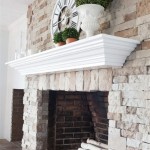Interior Design: Maximizing Small Living Room Space with a Fireplace
Incorporating a fireplace into a small living room presents a unique design challenge. While a fireplace often serves as a focal point and adds warmth and ambiance, its presence can also consume valuable real estate, especially in compact spaces. Successful design requires a thoughtful approach that balances the fireplace's functional and aesthetic benefits with the need to maximize space and maintain a sense of openness.
The core principles of small living room design – optimizing functionality, creating an illusion of spaciousness, and maintaining visual harmony – become even more critical when a fireplace is involved. Strategies for achieving these goals involve careful consideration of furniture placement, color palettes, lighting schemes, and the selection of design elements that complement both the fireplace and the room's overall aesthetic.
Optimizing Furniture Layout and Flow
Furniture arrangement is paramount in a small living room with a fireplace. A common mistake is to overcrowd the space with bulky pieces that obstruct the flow of movement and visually shrink the room. Prioritizing functionality and choosing furniture with clean lines and compact dimensions is essential.
Consider the fireplace's location when determining the optimal furniture layout. A symmetrical arrangement, with the fireplace as the central axis, can create a sense of balance and order. This typically involves flanking the fireplace with matching chairs or built-in shelving units. However, symmetry is not always the most practical solution, especially in rooms with irregular shapes or off-center fireplaces.
In asymmetrical layouts, the focus shifts to creating visual balance through the strategic placement of furniture and accessories. A large sofa placed on one side of the fireplace can be counterbalanced by a pair of chairs and a console table on the opposite side. This approach allows for greater flexibility and can be tailored to the specific dimensions and layout of the room.
Regardless of the chosen layout, it's crucial to maintain clear pathways for movement. Avoid placing furniture in a way that obstructs access to the fireplace or creates bottlenecks. Utilizing open-back furniture, such as chairs with slender legs or sofas with exposed frames, can help to maintain visual transparency and prevent the space from feeling cramped. Furthermore, a glass coffee table is good option, as it allows light to pass through it making the room feel bigger.
Multifunctional furniture is another valuable asset in small living rooms. Ottomans with built-in storage, coffee tables that can be raised to dining height, and sofa beds provide additional functionality without taking up extra space. These versatile pieces can be easily adapted to suit different needs and activities, maximizing the room's utility.
Enhancing Spaciousness through Color and Lighting
Color and lighting play a crucial role in creating the illusion of spaciousness in a small living room with a fireplace. Lighter colors reflect more light, making the room appear larger and brighter. Conversely, dark colors absorb light, which can make a small space feel even smaller and more enclosed.
A neutral color palette, consisting of whites, creams, grays, and pastel shades, is generally the best choice for small living rooms. These colors create a sense of airiness and provide a blank canvas for incorporating pops of color through accessories and artwork. A monochromatic color scheme, using different shades of the same color, can also be effective in creating a cohesive and streamlined look.
While lighter colors are generally preferred for walls and larger furniture pieces, darker colors can be used strategically to add depth and definition. For example, painting the fireplace surround a darker shade than the walls can help to make it a focal point and create visual interest. Darker accents, such as throw pillows, rugs, and artwork, can also be used to add contrast and prevent the room from feeling too bland.
Lighting is equally important in creating a sense of spaciousness. Natural light is always the best option, so it's important to maximize the amount of natural light that enters the room. This can be achieved by using sheer curtains or blinds, removing any obstructions from windows, and painting window frames a light color.
In addition to natural light, artificial lighting can also be used to brighten and expand the room. Layered lighting, consisting of ambient, task, and accent lighting, is the most effective approach. Ambient lighting, such as recessed lighting or a chandelier, provides overall illumination. Task lighting, such as a reading lamp or desk lamp, provides focused light for specific activities. Accent lighting, such as spotlights or wall sconces, highlights architectural features or artwork.
Placing mirrors strategically throughout the room can also enhance the sense of spaciousness. Mirrors reflect light and create the illusion of depth, making the room appear larger than it actually is. A large mirror placed on a wall opposite a window can be particularly effective in maximizing the amount of natural light in the room. Smaller mirrors can also be used to add visual interest and reflect light in specific areas.
Selecting Design Elements that Complement the Fireplace
The design elements chosen for a small living room with a fireplace should complement both the fireplace itself and the room's overall aesthetic. The style and materials used for the fireplace surround, mantel, and hearth should be consistent with the room's design theme. For example, a minimalist living room would benefit from a sleek, modern fireplace with a clean-lined surround, while a more traditional living room might feature a more ornate fireplace with a carved wooden mantel.
The choice of materials for the fireplace surround should also be considered carefully. Stone, brick, and tile are popular choices for fireplace surrounds, as they are durable, fire-resistant, and available in a wide range of styles and colors. However, these materials can also be quite heavy and can take up a significant amount of space. Lighter materials, such as wood or drywall, can be used to create a more streamlined and space-saving fireplace surround.
The mantel provides an opportunity to add personal touches and display decorative items. However, it's important to avoid cluttering the mantel with too many accessories, as this can make the room feel cramped and disorganized. A few carefully chosen items, such as a vase of flowers, a framed photograph, or a small sculpture, can be enough to add visual interest without overwhelming the space.
The hearth, the area in front of the fireplace, should also be considered in the design. The hearth provides a safe and fire-resistant surface in front of the fireplace. It can also be used as a seating area or a display surface. The size and style of the hearth should be proportionate to the size of the fireplace and the room. A large hearth can be visually imposing in a small living room, while a small hearth may not provide adequate protection. Consider adding rugs or carpets to hearth to add warmth and comfort.
Accessorizing the room with smaller items such as throw pillows, curtains, painting etc. are also essential. Throw pillows should be placed strategically on sofas and chairs to add comfort and visual interest. Choosing light and bright patterns or colors will help lighten the space.
Curtains can affect the amount of natural light that enters the room. Choosing sheer curtains will maximize the amount of natural light that comes into the room, while heavier drapes can block out light and make the room feel smaller. Blinds are also a good option for controlling the amount of light that enters the room.
Artwork can add personality and visual interest to a small living room. Choose artwork that is proportionate to the size of the room. Large pieces of artwork can overwhelm a small space, while small pieces of artwork may get lost. Hanging artwork at eye level will create a more pleasing aesthetic.
Ultimately, the key to successfully designing a small living room with a fireplace is to prioritize functionality, maximize space, and create a cohesive and visually appealing aesthetic. By carefully considering furniture placement, color palettes, lighting schemes, and the selection of design elements, it is possible to create a cozy and inviting living space that feels both spacious and stylish.
By considering all of these factors, any homeowner can transform a small living room with a fireplace into a stylish and functional space.

38 Small Yet Super Cozy Living Room Designs Design Family Rooms

Small Living Room Ideas Decorating Tips To Make A Feel Bigger Family Design Home Fireplace Built Ins

Fireplace Design Ideas For Your Home Designcafe

11 Appealing Living Room Designs With A Fireplace

15 Small Living Room Design Ideas You Ll Want To Steal

Fireplace Living Room Family Design Farm House Remodel

How To Arrange A Living Room With Fireplace House Of Hipsters

Sprucing Up Your Home S Living Room With Fireplace By Expert

How To Arrange A Living Room With Fireplace House Of Hipsters

30 Easy And Unexpected Living Room Decorating Ideas With Fireplace Family Design








